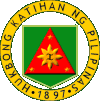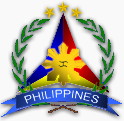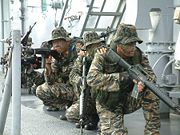Armed Forces of the Philippines
From Worldatplay
| Line 116: | Line 116: | ||
==Current officers of the AFP== | ==Current officers of the AFP== | ||
| - | *President | + | *President Benigno Simeon C. Aquino III: Commander-in-Chief of the Armed Forces of the Philippines |
| - | *Secretary | + | *Secretary Voltaire Gazmin.: Secretary of National Defense |
| - | *General | + | *General Ricardo David Jr.: Chief of Staff of the Armed Forces of the Philippines |
| - | *Lieutenant General | + | *Lieutenant General Reynaldo Mapagu: Vice Chief of Staff of the Armed Forces of the Philippines |
| - | * | + | *Lieutenant General Eduardo SL Oban: Deputy Chief of Staff of the Armed Forces of the Philippines |
| - | *Lieutenant General | + | *Lieutenant General Arturo Ortiz: Commanding General of the Philippine Army |
| - | * | + | *Rear Admiral Alexander Pama: Flag Officer in Command of the Philippine Navy |
| - | *Lieutenant General | + | *Lieutenant General Oscar Rabena: Commanding General of the Philippine Air Force |
[[Category:Armed forces by country|Philippines, Armed Forces of the]] | [[Category:Armed forces by country|Philippines, Armed Forces of the]] | ||
[[Category:Military of the Philippines| ]] | [[Category:Military of the Philippines| ]] | ||
Revision as of 17:59, 14 February 2011




The Armed Forces of the Philippines or AFP (Filipino: Sandatahang Lakas ng Pilipinas) is the overall unified military of the Republic of the Philippines.
Its component branches include:
The constitution puts the AFP under the control of a civilian, the President of the Republic of the Philippines, who acts as its Commander-in-Chief. All of its branches are part of the Department of National Defense, which is headed by the Secretary of National Defense. The Secretary is technically a civilian but there had been many instances where the Secretary is a former or retired uniformed personnel of the AFP or Philippine National Police.
AFP currently has a total of 113,500 people on active duty and 131,000 people on reserve. Currently, as it is peace time, AFP is a volunteer military. No conscription is done. Women are allowed to join AFP but they are not assigned in combat positions. A considerable fraction of these women are commissioned officers. The average age of its manpower is 18 years old; males aged 15 through 49 are eligible for recruitment and active duty. The 1998 fiscal year expenditures for the Armed Forces of the Philippines totaled 1.5% of the gross domestic product.
Due to its close relationship with the United States military establishment, AFP was considered the strongest national defense program in Asia — especially in the 1950s and 1960s. In 2007, the China Economic Net reported information from a Bangkok-based think tank that the Philippines is the most dependent on U.S. military assistance in all the East Asian countries — receiving approximately 85 percent of the total U.S. military assistance allocated to Southeast Asia, over 10 times more than the next biggest recipient.
AFP is considered to be one of the most stressed militaries in the world. It is at constant war against local secessionist forces like New People's Army, Moro Islamic Liberation Front, and Abu Sayyaf. It is the primary force used for disaster response during calamities like tropical storms, earthquakes, and landslides. However, while being a relatively weak military compared to other countries because of the lack of technologically advanced weapons, AFP soldiers are considered to be one of the most hardened soldiers in the world. Their century long experience in jungle warfare in combating secessionist forces with limited weaponry and technology earned them such description.
Contents |
History
AFP trace its roots from Katipunan, the revolutionary force founded by Andres Bonifacio in 1892 which waged a war against Spain and United States for Philippine Independence. Katipunan, officially known as Kataas-taasang, Kagalang-galangang Katipunan ng mga Anak ng Bayan (Supreme and Venerable Society of the Children of the Nation) or KKK, is composed mainly by peasants who were attracted by Bonifacio's charisma in demanding Independence from Spain. Later, wealthy Filipinos, many of them were able to finish college in Europe, joined the Katipunan. They are the ones who held most of the higher military and administrative positions.
Even before United States went on the scene, Katipunan has gained many victories against Spanish troops, mainly composed also of native Filipinos who were hired by the Spanish government. When Spanish-American War erupted in 1898, United States offered to help Katipunan fight the Spanish troops in the Philippines. Emilio Aguinaldo -who was by that time in exile in Hong Kong after Spanish troops gained some advantage- accepted the offer. Spanish troops were weakened within a month and on June 12, 1898, the Philippine Independence were declared. The Philippine Declaration of Independence was signed by ninety-eight individuals, including an American military officer who witnessed the event. This event brought the very first republic in Asia, though it was de facto. The republic established is commonly known as the First Philippine Republic, as opposed to the Second Philippine Republic which was a puppet to Japan during World War II and the Third Philippine Republic which was the current Republic of the Philippines which gained independence from United States in July 4, 1946. At first it took a dictatorial form of government and was replaced by a revolutionary government headed by Emilio Aguinaldo as president on June 23, 1898. The First Philippine Republic was formally established with the proclamation of the Malolos Constitution on January 23, 1899. When it became apparent to Katipunan that United States has no intention of recognizing the newly-establish Republic, the Philippine-American War erupted. Katipunan, which lacked sufficient amount of armor and ammunition, lost many battles. By 1901, Katipunan completely lost the war.
Oddly however, its modern establishment originated in the establishment of the Philippine Scouts in 1901 by the United States which has the purpose of assisting in combating the Katipunan itself. When AFP was formally organized during the American Commonwealth era through Commonwealth Act No. 1 or the National Defense Act of December 21, 1935, the Philippine Commonwealth government recognized Katipunan as its original predecessor. This is evident in the official seal of the Philippine Army which has 1897 as its founding year, the year Andres Bonifacio officially launched war against Spain.
During the Philippine Commonwealth era, President Manuel Quezon, the first President of the Commonwealth, hired Gen. Douglas MacArthur, an American general, to be the first head of AFP (AFP was first known as plainly Philippine Army. It is only after United States had given Philippines its independence on July 4, 1946 when AFP became its official name.) MacArthur accepted the offer and became the first and only person of foreign citizenship to be in the ranks of AFP. Furthermore, he held the rank of a Field Marshal, the rank no other person had ever earned in AFP. MacArthur had made Philippine military a strong army, as what he is supposed to do when Quezon hired him. This strength of the Philippine military had later played an important role during the World War II. Japanese forces, unaware of the true strength of the combined US and Philippine military, had needed to redirect many of its forces to the Philippines, slowing and eventually halting its movement towards Australia.
During World War II, all soldiers of the Philippine military was incorporated in United States Armed Forces in the Far East (USAFFE) in which MacArthur was appointed as its head. USAFFE made its last stand in Corregidor Island in the Philippines when Japanese forces were able to make all remaining Filipino and American troops to surrender. After Japan was defeated in World War II, Philippines gained its independence (Its second independence. Philippines recognizes Aguinaldo's declaration of independence back in 1898 as its original independence year). Philippines and United States maintained a tight and mutual relationship since then making AFP one of the strongest military in Asia during 1950's to 70's.
Organizations and Branches
The President of the Philippines, serving as the Commander-in-Chief, is the head of AFP and all other uniformed services in the Philippines. The Secretary of National Defense, the head of Department of National Defence, serves as the right hand of the President in the administration of AFP.
AFP has three major branches: the Philippine Army or Hukbong Katihan ng Pilipinas, Philippine Navy or Hukbong Dagat ng Pilipinas and Philippine Air Force or Hukbong Himpapawid ng Pilipinas. These three major branches are unified under a Chief of Staff which normally hold a rank of General. He is assisted by a Vice Chief of Staff (Lieutenant General) and a Deputy Chief of Staff (Major General). The three major branches are each headed by an officer with the following position titles: Commanding General of the Philippine Army (Lieutenant General), Flag Officer in Command of the Philippine Navy (Vice-Admiral), and Commanding General of the Philippine Air Force (Lieutenant General).
Rank Structure and Military Units
AFP rank structure is almost similar to the rank structure of the United States military for both Non-commissioned and commissioned officers. The only significance difference is the absence of Warrant Officers in AFP ranks.
Philippine Army, Philippine Air Force and Philippine Marine Corps
This rank structure is exactly the same with the US military and applies for Philippine Army (PA), Philippine Air Force (PAF) and Philippine Marine Corps (PMC) and all their sub-branches like Philippine Scout Rangers and Presidential Security Group. The military divisions or units and their corresponding commanding officers which appear below are not applicable to PAF.
Commissioned Officers
| Rank | Abbreviation | Pay Grade | Notes |
|---|---|---|---|
| Second Lieutenant | 2LT | O-1 | The lowest rank among Commissioned Officers. Can be obtained upon graduation from Philippine Military Academy or from Officer Candidate School, Call to Active Duty (CAD), and the ROTC. |
| First Lieutenant | 1LT | O-2 | A Platoon leader has this rank. A Platoon is typically composed of four squads (containing about 10 privates and/or corporals) which are led by staff sergeants. |
| Captain | CPT | O-3 | A Company Commanding Officer has this rank. A company is composed by two to four platoons. |
| Major | MAJ | O-4 | Primarily, the officers who hold positions one step below a Battalion Commanding Officer like Battalion Executive Officer (XO) and Battalion Intelligence Officer (S2) have this rank. |
| Lieutenant Colonel | LT COL | O-5 | A Battalion Commanding Officer has this rank. Also, the officers who hold positions one step below a Regimental Commanding Officer like Regimental Executive Officer (XO) and Regimental Intelligence Officer (G2) have this rank. A battalion is composed by two to four companies. |
| Colonel | COL | O-6 | A Regimental Commanding Officer has this rank. A regiment is composed by two to three Battalions. |
| Brigadier General | B/GEN | O-7 | One-star. A Brigade Commanding Officer has this rank. A brigade is composed of two regiments. |
| Major General | MAJ GEN | O-8 | Two-star. A Division Commanding Officer has this rank. A division is composed of two brigades. The Philippine Marine Corps Chief has this rank. |
| Lieutenant General | LT GEN | O-9 | Three-star. The Philippine Army Chief and the Philippine Air Force Chief have this rank. |
| General | GEN | O-10 | Four-star. The Armed Forces of the Philippines Chief of Staff has this rank. This is the highest attainable rank in AFP. |
| Five-star. Unlike in the US military, AFP has no five-star general generally because AFP cannot afford to make the Corps and Field divisions within AFP. The largest unit in AFP is Division. US has Corps and Field as the largest units which are double and quadraple the size of Division respectively. By comparison, US Army and US Air Force has chiefs which are five-stars (Official rank names are General of the Army and General of the Air Force) while PA and PAF have chiefs which are three-stars. |
Philippine Navy and Philippine Coast Guard
Commissioned Officers
| Rank | Abbreviation | Pay Grade | Notes |
|---|---|---|---|
| Ensign | ENS | O-1 | The lowest rank among Commissioned Officers. Can be obtained upon graduation from Philippine Military Academy or from Officer Candidate School, Call to Active Duty (CAD), and the ROTC. Equivalent to Second Lieutenant of PA and PAF. |
| Lieutenant, Junior Grade | LT JG | O-2 | Equivalent to First Lieutenant of PA, PAF and PMC. |
| Lieutenant, Senior Grade | LT SG | O-3 | The equivalent US military rank for this is a plain "Lieutenant" rank. Equivalent to Captain of PA, PAF and PMC. |
| Lieutenant Commander | LT CDR | O-4 | Equivalent to Major of PA, PAF and PMC. |
| Commander | CDR | O-5 | Equivalent to Lieutenant Colonel of PA, PAF and PMC. |
| Navy Captain | N CAPT | O-6 | The equivalent US military rank for this is a plain "Captain" rank. Equivalent to Colonel of PA, PAF and PMC. |
| Commodore | CDRE | O-7 | One-star. The equivalent US military rank for this is "Rear Admiral (Lower Half)" rank. Equivalent to Brigadier General of PA, PAF and PMC. |
| Rear Admiral | R/ADM | O-8 | Two-star. The equivalent US military rank for this is a plain "Rear Admiral (Upper Half)" rank. Equivalent to Major General of PA, PAF and PMC. Philippine Coast Guard Chief has this rank. |
| Vice Admiral | VADM | O-9 | Three-star. The highest attainable rank in Philippine Navy. The Philippine Navy Chief (Flag Officer in Command) has this rank. Equivalent to Lieutenant General of PA and PAF. |
| Four-star. US military designate this rank as plain "Admiral." AFP does not have this rank. The equivalent rank for this in AFP is "General" which is the highest rank and held by the AFP Chief of Staff. Whenever a Philippine Navy Chief who has the rank of a Vice-Admiral becomes the AFP Chief of Staff, he/she takes the rank of General, not Admiral. | |||
| Five-star. The highest attainable rank in AFP is the [four-star] General, which is the rank of AFP Chief of Staff. By comparison, US Navy is headed by a Fleet Admiral which is a five-star while PN Chief is just a Vice-Admiral. |
AFP Special Forces Units
- Philippine Marine Corps - The units of the 8,000-strong Philippine Marine Corps (PMC) are often the first to be called to respond to a crisis.
- Philippine Naval Special Warfare Group (SWAG) - Supporting the Marines is the Philippine Navy's Special Warfare Group (SWAG) whose main unit is the Philippine SEALs (Sea-Air-Land). The Search brigade is divided into thirty teams. Their basic training lasts six months and has a 75% to 90% percent dropout rate. SEAL training includes demolitions, cartography, scuba, parachuting and hand-to-hand combat. SEALs train regularly with their American counterparts in an annual amphibious exercise codenamed "Palau". In 1996, Filipino and American SEALs trained in Palawan island near the Spratlys.
- Philippine Army Special Operations Command (PA SOCOM) - Philippine Army Special Operations Command (PA SOCOM) is composed of over 6,000 troops divided into the 1st Scout Ranger Regiment, 1st Special Forces Regiment (Airborne) and The "Delta Force" of the Philippine Army is the elite Light Reaction Battalion or LRB trained in counter-terrorist operations.
Under the Special Forces Regiment (SFR(A)) of the Philippine Army is the 1st Riverine (SF) Battalion equipped with 50 footer fast assault boats. This Special Forces seaborne battalion works together with the Seaborne Brigade of the 1st Infantry (Tabak "Machete") Division. Both Army seaborne units are based in Sulu near the Spratly islands.
- Philippine Air Force RDU - The rapid deployment force of the Philippine Air Force (PAF) is the 710th Special Operations Wing divided into ten (10)-man airborne attack teams. Supporting units include the Air Commando Squadrons of the 15th Strike Wing under the Tactical Operations Command. Its official mission is to "conduct contingency operations against hostile elements."
Current officers of the AFP
- President Benigno Simeon C. Aquino III: Commander-in-Chief of the Armed Forces of the Philippines
- Secretary Voltaire Gazmin.: Secretary of National Defense
- General Ricardo David Jr.: Chief of Staff of the Armed Forces of the Philippines
- Lieutenant General Reynaldo Mapagu: Vice Chief of Staff of the Armed Forces of the Philippines
- Lieutenant General Eduardo SL Oban: Deputy Chief of Staff of the Armed Forces of the Philippines
- Lieutenant General Arturo Ortiz: Commanding General of the Philippine Army
- Rear Admiral Alexander Pama: Flag Officer in Command of the Philippine Navy
- Lieutenant General Oscar Rabena: Commanding General of the Philippine Air Force


